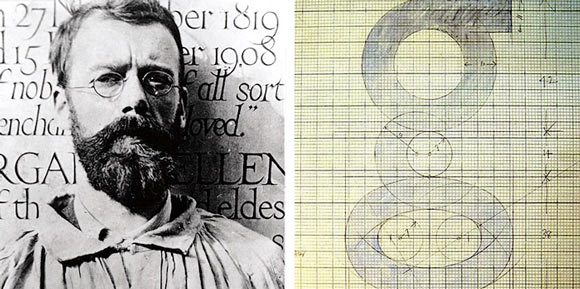
Eric Gill was a twentieth century British sculptor, printmaker and typeface designer. He was known for his association with the Arts and Crafts movement. Gill is considered a rather infamous figure for his controversial stance on art that most often involved erotic imagery, despite his strong religious views. He received the highest British award for designers, Royal Designer for Industry.
On February 22, 1882, in Steyning, Sussex, he was born Arthur Eric Rowton Gill. The inclination toward creative art ran in the family as his elder brother of MacDonald Gill followed the path of graphic designing attaining immense success. When he was 15, the family moved to Chichester where he was enrolled at Chichester Technical and Art School. Three years later he moved to London and obtained training as an architect. He took evening classes at Westminster Technical Institute studying stonemasonary and at the Central School of Arts and Crafts learning calligraphy. Gill withdrew himself from architectural training with the intention of pursuing calligraphy, monumental-masonry and letter-cutting.
Subsequent to his settling in Ditchling in Sussex after marriage, he began direct carving of stone figures, in 1910. Gill sculpture Madonna and Child (1910) received harsh criticism as it was described by an art critic Fry as depiction of ‘pathetic animalism’. His semi-abstract sculptures highlights his appreciation of Egyptian, Greek, medieval ecclesiastical statuary, Indian sculpture and the Post-Impressionism. Gill encountered public success for the first time with his art piece Mother and Child (1912). He was highly fascinated by Indian traditional sculptures. Hence, he planned to construct an enormous hand-carved monument in Sussex countryside, imitating Jain structures at Gwalior Fort in India. In 1914, he sculptured for the Stations of the Cross. He was commissioned by the University of Leeds to produce a war memorial. It also held a controversial element that was his depiction of Jesus driving out money-changers from the temple.
After moving to Capel-y-ffin in Powys, Gill established a workshop and then a printing press in 1928. A number of zealous apprentices sought his supervision. He guided many of the successful artists including Walter Ritchie, David Kindersley, Donald Potter and John Skelton, who later became notable sculptors. Three of eight relief sculptures following the wind theme were carved by Gill for Transport for London at 55 Broadway. Another one of his sculpture for public display included the Virgin and Child. A group of sculptures, Prospero and Ariel, were produced by him, in 1932. The BBC’s Broadcasting House was also one of his leading clients. Furthermore, he carved two seahorses, a large stone relief of Odysseus for The Art Deco Midland Hotel.
Besides, Gill designed the typeface, Perpetua, modeled after the monumental Roman inscriptions. In 1930, he produced Gill Sans typeface inspired by the Sans Serif lettering. It was followed by a variety of typefaces, including Perpetua Greek, Solus, Aries, Bunyan and Joanna. Additionally, he penned multitude of essays discussing the relationship between art and religion, such as A Holy Tradition of Working: An Anthology of Writings, Christianity and Art, An Essay on Typography and Work and Culture.
Eric Gill was a very popular sculptor of his time. However, his personal life remained highly scandalous as he was accused of disturbing sexual conduct. In 1940, he died of lung cancer in Middlesex and interred at Speen churchyard in the Chilterns. The University of California (UCLA) archived his papers and book collection at the William Andrews Clark Memorial Library.

